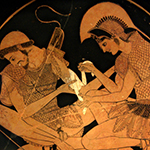Coventry University Professor of Theoretical Physics, Ralph Kenna, has achieved international press for his recent work surrounding the connections between modern social networks, and the ones in mythological narratives.
The New York Times published an article entitled ‘If Achilles Used Facebook’ in September 2012, which you can read here in its entirety, for your convenience. It is a perfect example of the types of new and groundbreaking research taking place here at Coventry University.
When we pick up a mythological text like “The Iliad” or “Beowulf,” we like to imagine that the societies they describe existed. Even if the stories are fiction, we believe that they tell us something about ancient Greece or the Anglo-Saxons, and that some of the characters and events were based on reality.
Archaeological evidence suggests that at least some of the societies and events in such stories did exist. But is there other evidence, lurking perhaps within the ancient texts themselves?
To investigate that question, we turned to a decidedly modern tool: social-network analysis. In a study published in Europhysics Letters, we use a mathematical approach to examine the social networks in three narratives: “The Iliad,” “Beowulf” and the Irish epic “Tain Bo Cuailnge.” If the social networks depicted appeared realistic, we surmised, perhaps they would reflect some degree of historical reality.
Social networks have been widely studied in recent years; researchers have looked at the interconnectedness of groups like actors, musicians and co-authors of scientific texts. These networks share similar properties: they are highly connected, small worlds. They are assortative, which means that people tend to associate with people like themselves. And their degree distributions are usually scale-free — a small number of people tend to have lots of friends.
How do these networks compare to the ones in mythological narratives? We started with two narratives that some believe to be partly based in history.
“Beowulf” is an Anglo-Saxon heroic epic, set in Scandinavia. Notwithstanding obvious embellishments, archaeology supports the historical authenticity associated with some of its characters. The main character, Beowulf, is believed to be fictional.
Our second text, “The Iliad,” is an epic poem attributed to Homer dating from the eighth century B.C. Some archaeological evidence suggests that the story is based on an actual conflict.
We contrasted those two narratives with the Irish epic “Tain Bo Cuailnge” (usually called the “Tain”), which most believe to be completely fictional. The “Tain,” which survives in three manuscripts from between the 12th and 14th centuries, concerns a conflict between Connaught and Ulster, Ireland’s western and northern provinces.
Before it was written down, the “Tain” had an extensive oral history. Medieval scholars dated it from the first centuries B.C., but this may have been an attempt to artificially synchronize oral traditions with biblical and classical history.
The “Tain”’s historicity is debated: some say it corroborates Greek and Roman accounts of the Celts; others say it has no historical basis whatsoever.
To construct the social networks in each of the narratives, we created databases for the characters and their interactions, and we categorized their relationships as hostile or friendly.
The myth networks were found to have some of the characteristics, including the small-world property and structural balance (related to the idea that the enemy of my enemy is my friend), typical of real-world networks.
Intentionally fictional narratives like “Harry Potter” also have these properties. However, “The Iliad” is assortative as well — a potential real-life indicator that these fictional networks lack. “Beowulf” is also assortative, but only if the main character, who is very different from the rest, is removed from the network. The “Tain,” like the fictional networks we studied, is disassortative.
These and other features may corroborate scholars’ belief in the narratives’ historical basis: i.e., the societies underlying “The Iliad” and “Beowulf” may have traces of reality, while that of the “Tain” appears more artificial.
But just how fictional is the “Tain”? We looked further into the degree distributions of the social networks — at the frequency of popularity among characters. Like real networks, all three were scale-free, unlike any of the intentionally fictional narratives examined.
In this regard, the majority of the “Tain” and “Beowulf” were similarly realistic — except that in the Irish myth, the top six characters are all unrealistically well connected, giving it both fictional and real characteristics.
But there are 398 other characters in the “Tain,” and when we remove the weakest links (or single, direct encounters) between these characters and the Top 6, the narrative becomes as realistic as “Beowulf” from a social-network view. Perhaps these characters are amalgams of a number of entities that were fused as the narrative was passed down orally.
Our initial results may therefore corroborate existing interpretations of “Beowulf” and “The Iliad” as being at least partly historical. They also signal that the society in the “Tain” may have a similar level of historicity.
Our approach is different from traditional approaches to comparative mythology. It is not literary analysis; it tells us nothing about events or the human condition. Instead, it promises a new way to analyze old material and find striking new perspectives and evidence — in this case, that which we call “myths” may not be as mythical as we thought.




Comments are disabled